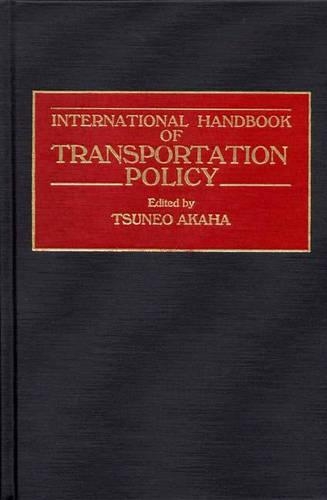
International Handbook of Transportation Policy
(Hardback)
Publishing Details
International Handbook of Transportation Policy
By (Author) Tsuneo Akaha
Bloomsbury Publishing PLC
Greenwood Press
27th August 1990
United States
Classifications
Tertiary Education
Non Fiction
Transport industries
Reference works
388
Physical Properties
Hardback
408
Width 156mm, Height 235mm
737g
Description
This is a valuable, well-written book on the development and current state of intercity passenger and freight transportation in 12 countries (Brazil, China, East Germany, France, Japan, Korea, Mexico, the USSR, the UK, the US, West Germany, and Zaire). Locations studied represent a good mix of advanced and developing countries with market and centrally planned economies. Choice This volume surveys the public transportation systems and policies of twelve countries. It is concerned with the selected countries' experiences with the development, maintenance, and use of publicly provided transportation infrastructure for both public (commercial) and private (individual) purposes. The diversity of the countries surveyed, both in terms of the type of economic system and the level of economic development, provides rich and varied national experiences from which lessons can be learned. The volume allows the reader to compare and contrast different needs and policy responses in the public transportation sector of the countries selected. All modes of transportation are covered and both passenger and freight/cargo transportation are included. Narrative descriptions of transportation modes are accompanied by quantitative indicators of the volume of transportation and other related data. Each country chapter provides the following information: historical and geographical factors influencing the development and maintenance of the country's public transportation system and policy; the impact of socioeconomic changes and political and ideological factors on a country's public transportation system and policies; recent trends and future prospects in public transportation; and transportation policy organization and process. The survey covers the post-World War II period through 1987-88. The country chapters are followed by a bibliographical essay that introduces a selective collection of English-language materials on public transportation systems and policies in the twelve countries surveyed, as well as additional, general works on public transportation. This unique work will be an invaluable resource for anyone interested in a cross-cultural perspective on transportation policy.
Reviews
This is a valuable, well-written book on the development and current state of intercity passenger and freight transportation in 12 countries (Brazil, China, East Germany, France, Japan, Korea, Mexico, the USSR, the UK, the US, West Germany, and Zaire). Locations studied represent a good mix of advanced and developing countries with market and centrally planned economies. Most chapters are separately authored and focus on individual countries, but they are written in a common format (including aggregate tables on modal investments, size of traffic networks, and volumes, and sections on historical development, political factors, existing organizations, and policy-making processes). However, despite the title, this is not a how-to book. In fact its major weaknesses are the lack of a good synthesis on how and why different countries do things differently and the absence of useful generalizations on 'how to do it better.' This may reflect its authorship by political scientists rather than transportation policy specialists. The printing, binding, and index are excellent, but the tables and transportation network maps are only fair. Strengths of the book are its descriptive coverage and superb bibliographies and references on each country. There is no comparable up-to-date book. Upper-division and graduate collections.-Choice
"This is a valuable, well-written book on the development and current state of intercity passenger and freight transportation in 12 countries (Brazil, China, East Germany, France, Japan, Korea, Mexico, the USSR, the UK, the US, West Germany, and Zaire). Locations studied represent a good mix of advanced and developing countries with market and centrally planned economies. Most chapters are separately authored and focus on individual countries, but they are written in a common format (including aggregate tables on modal investments, size of traffic networks, and volumes, and sections on historical development, political factors, existing organizations, and policy-making processes). However, despite the title, this is not a how-to book. In fact its major weaknesses are the lack of a good synthesis on how and why different countries do things differently and the absence of useful generalizations on 'how to do it better.' This may reflect its authorship by political scientists rather than transportation policy specialists. The printing, binding, and index are excellent, but the tables and transportation network maps are only fair. Strengths of the book are its descriptive coverage and superb bibliographies and references on each country. There is no comparable up-to-date book. Upper-division and graduate collections."-Choice
Author Bio
TSUNEO AKAHA is Associate Professor of International Studies at the Monterey Institute of International Studies. He is the author of Japan in Global Ocean Politics, coauthor of Japan and the New Ocean Regime, and the author of numerous articles which have appeared in journals such as Asian Survey, Pacific Affairs, American Political Science Review, and Millenium: Journal of International Studies.
